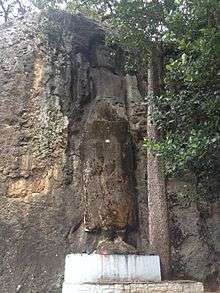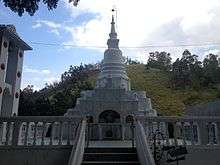Dhowa rock temple
| Dhowa rock temple දෝව රජ මහා විහාරය | |
|---|---|
 The unfinished Buddha image at Dhowa Raja Maha Vihara | |
| Basic information | |
| Location | Dhowa, Bandarawela, Sri Lanka |
| Affiliation | Buddhism |
| District | Badulla |
| Province | Uva Province |
| Heritage designation | Archaeological protected monument[1] (1 November 1996) |
| Architectural description | |
| Architectural type | Buddhist Temple |
Dhowa Rock Temple (Sinhala :දෝව රජ මහා විහාරය) is a protected heritage site in Sri Lanka, situated in the central mountains of the Uva province. Dhowa is a small, ancient village situated on the Badulla - Bandarawela main road. This temple is situated 210 km (130 mi) east of Colombo and 120 km (75 mi) south of Kandy.[2]
The Dhowa rock temple is famous for its large unfinished Buddha image, carved into the rock face, which is considered an example of Mahayana sculpture. The temple dates back over 2000 years.[3][4]The area gained the name Dhowa as it is located within a ring of mountains, with a river which flows across the plateau.
History
It is believed that the temple bears a history dating back to about 2,000 years. Historically, the Dhowa temple was known as the Kumbaltissa Ariyagala Vehera, named after its chief priest who had provided sanctuary for King Walagamba, who turned the cave into a temple.[5]
Work at the temple was not completed during the reign of King Walagamba, but was fully completed during the Kandyan Kingdom.
Attractions

The 12 m (39 ft) rock carved Buddha statue and the ornamental gateway are the main attractions of the temple. The statue is in a state of ruin due to rapid decaying.
Folk tales hold that the half finished Buddha statue was carved by King Walagamba himself while hiding in this caves during foreign invasions. The king is said to have left the area before he could finish carving the statue, thus leaving it half finished.
Paintings
The paintings of the shrine room had been decorated with the influence of the Kandyan era. These paintings depict various Jathaka stories. The canopy of the rock is decked with paintings of lotus and various other flowers. Among these paintings, the Ath-Gon Satana (battle between a tusker and a bull) is featured. The priority had been given to the cobra image in the structure of the temple. The cobra had been featured in the paintings as well as on the jug used for serving water to Buddha.
See also
References
- ↑ "Protected Monument List 2012-12-12" (PDF). Department of Archaeology. 12 December 2012. Retrieved 27 March 2016.
- ↑ Dowa Cave Temple
- ↑ The secrets of Dhowa Raja maha Viharaya
- ↑ Caving in Sri Lanka
- ↑ Dowa Cave Temple